The NVIDIA GeForce GTX 780 Ti Review
by Ryan Smith on November 7, 2013 9:01 AM ESTPower, Temperature, & Noise
As always, last but not least is our look at power, temperature, and noise. Next to price and performance of course, these are some of the most important aspects of a GPU, due in large part to the impact of noise. All things considered, a loud card is undesirable unless there’s a sufficiently good reason – or sufficiently good performance – to ignore the noise.
| GeForce GTX 780 Series Voltages | ||||
| GTX 780 Ti Boost Voltage | GTX 780 Boost Voltage | GTX 780 Ti Base Voltage | ||
| 1.187v | 1.1625v | 1.012v | ||
Taking a quick look at voltages, we find that our GTX 780 Ti operates at a slightly higher voltage at its maximum boost bin than the original GTX 780 did. The difference is minor, but the additional voltage may be necessary to hit the slightly higher clockspeeds GTX 780 Ti operates at relative to GTX Titan and GTX 780.
| GeForce GTX 780 Ti Average Clockspeeds | |||
| Max Boost Clock | 1020MHz | ||
| Metro: LL |
1000MHz
|
||
| CoH2 |
997MHz
|
||
| Bioshock |
954MHz
|
||
| Battlefield 3 |
980MHz
|
||
| Crysis 3 |
980MHz
|
||
| Crysis: Warhead |
1000MHz
|
||
| TW: Rome 2 |
950MHz
|
||
| Hitman |
993MHz
|
||
| GRID 2 |
967MHz
|
||
| Furmark |
823MHz
|
||
Moving on to clockspeeds, we find that the GTX 780 Ti does very well when it comes to boosting. With a maximum boost clock of 1020MHz, we have 2 benchmarks averaging 1000MHz, and another 4 averaging 980MHz or better.
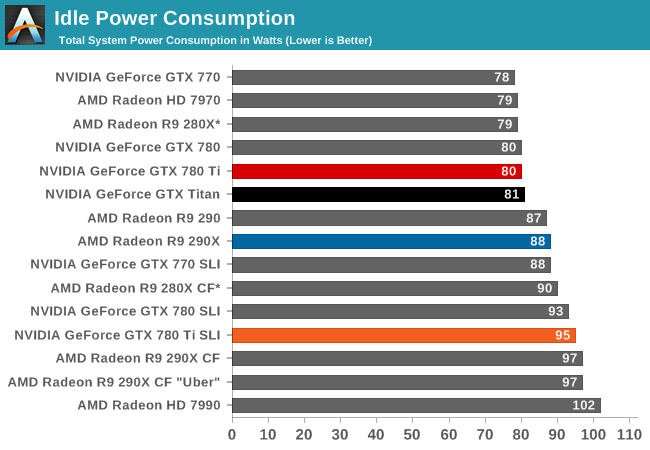
With all of our GK110 cards sharing a common design, at idle there’s very little to differentiate them. Other than GTX Titan’s extra 3GB of VRAM, we’re essentially looking at identical cards when idling.
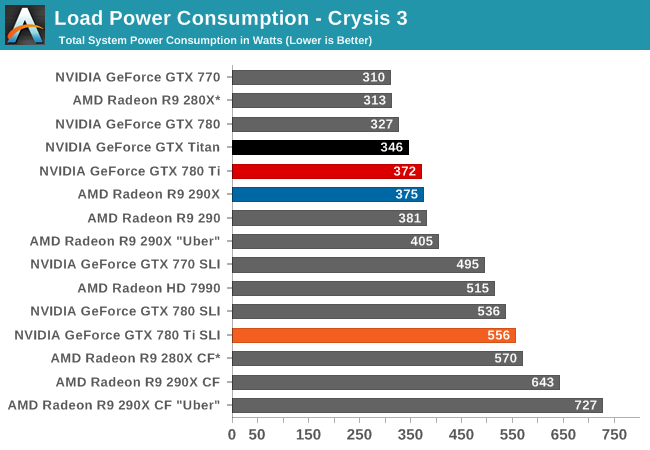
Moving on to load power, we can see the power/heat ramifications of the slight clockspeed increase coupled with the activation of the 15th SMX. Even with the further optimizations NVIDIA has put into the new revision of GK110, power consumption has gone up in accordance with the higher performance of the card, just as we’d expect. Since NVIDIA doesn’t notably alter their power efficiency here, that increased performance has to come at the cost of increased power consumption. Though in this benchmark it’s worth pointing out that we’re measuring from the wall and that GTX 780 Ti outperforms GTX Titan by 8%, so some of that 29W power difference will come from the higher CPU load caused by the increased framerates.
As for the GTX 780 Ti SLI, here we see power level off at 556W, 20W more than the GTX 780 SLI. Some (if not most) of that is going to be explained by the increased CPU power consumption from the GTX 780 Ti SLI’s higher framerates. Coupled with that is the fact that in SLI setups these cards get hotter, and hence have to downclock a bit more to maintain equilibrium, which helps to offset the increased power requirements of GTX 780 Ti and keep the SLI results so close to the GTX 780 SLI results.
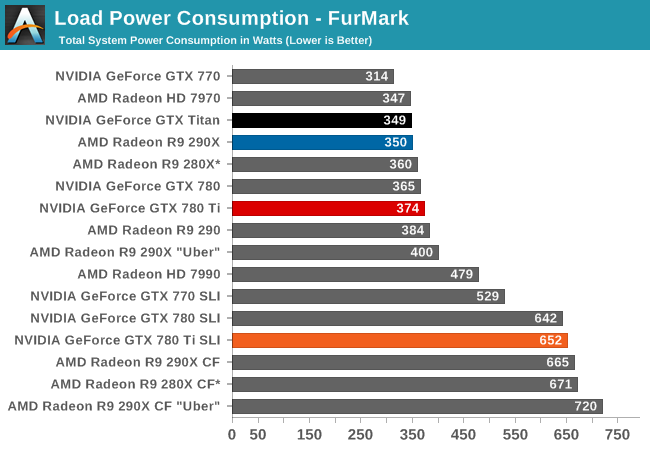
Switching over to FurMark, we find that power consumption is also up, but only slightly. With GPU Boost 2.0 clamping down on power consumption all of our GK110 cards should be clamped at 250W here, and with a difference between GTX 780 and GTX 780 Ti of under 10W, that’s exactly what appears to be happening here.
On a side note, it’s interesting to note here that under FurMark we’re seeing the GTX 780 Ti draw more power than the Radeon R9 290X. Despite the fact that the 290X has a higher rated TDP, in the card’s default quiet mode the card can’t actually dissipate as much heat (and thereby consume as much power) as the GTX 780 Ti can.
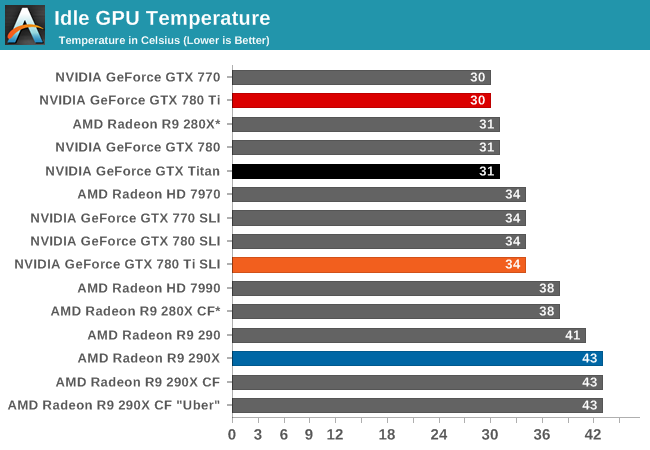
For idle temperatures we’re once again looking at cards that are for all intents and purposes identical. At 30C the GTX 780 Ti easily stays nice and cool.
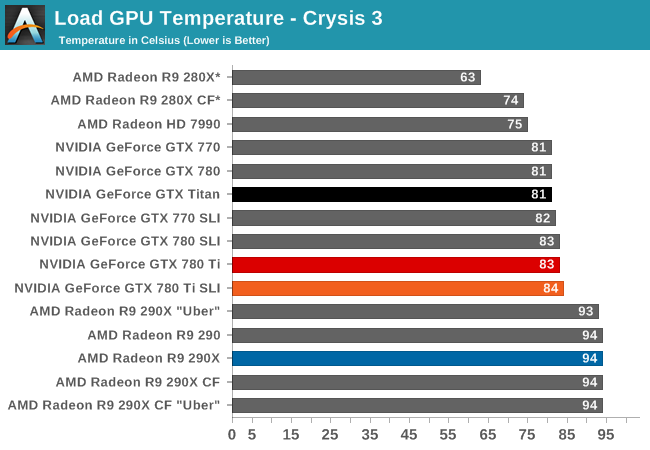
As we mentioned in our look at the GTX 780 Ti hardware, NVIDIA has increased their default temperature throttle point from 80C on the GTX Titan/780 to 83C on the GTX 780 Ti. The end result is that in all of our temperature limited tests the GTX 780 Ti will peak at 83C-84C, whereas the older GK110 cards will peak at 80C-81C.

FurMark reiterates what we saw with Crysis 3. The temps are up a bit across the board, while the GK110 cards are holding near their throttle points. The SLI setups meanwhile approach the upper-80s at 88C, reflecting the fact that even with blowers, there’s some impact on neighboring cards in high load situations.
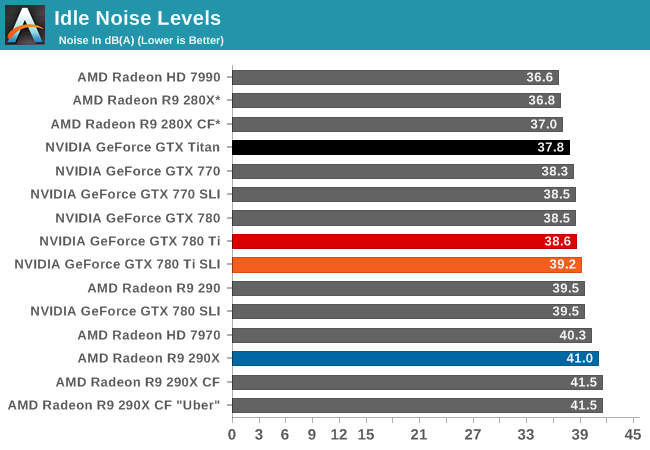
Our last idle scenario, we once again see all of our GK110 cards performing similarly, with idle noise levels in the 38dB-39dB range.
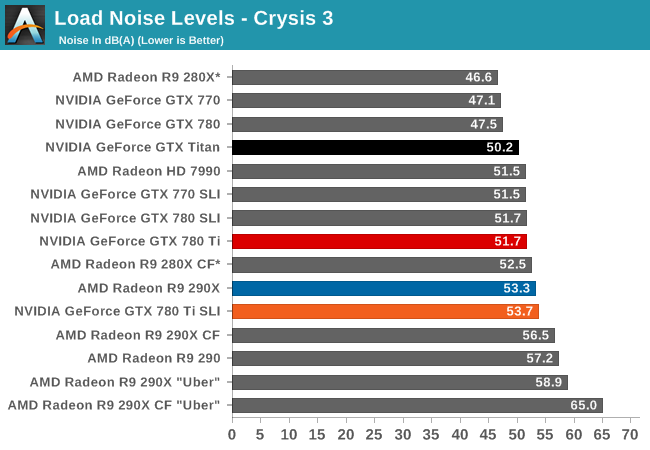
Moving on to our gaming load noise results, we can see the full repercussions of the GTX 780 Ti’s higher average power consumption coupled with the card’s higher temperature throttle point. Moving the throttle point along the same curve has the end result of moving higher the equilibrium point and thereby the card’s operating noise levels. As the fastest single-GPU card on this card, the GTX 780 Ti is still doing very well for itself and for a blower based design at 51.7dB, though at 1.5dB louder than GTX Titan and 4.2dB louder than GTX 780 the noise tradeoff for the card’s higher performance is very clear. Meanwhile the fact that it’s tied with the GTX 780 SLI comes with its own bit of irony.
Speaking of the GTX 780 SLI, we can see the noise impact of SLI configurations too. The GTX 780 Ti SLI levels out at 53.7dB, 2dB louder than our single-card configuration and 2dB louder than the GTX 780 SLI. At this point it’s just a bit louder than the 290X and quieter than a number of other 290 series setups.
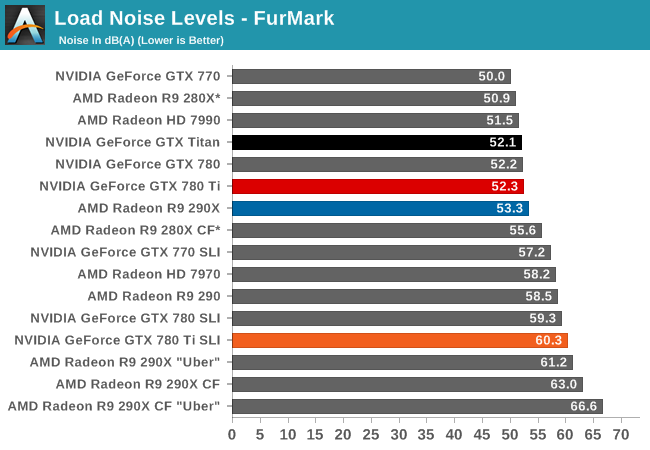
Finally with load noise levels under FurMark we can see where our various cards will peak at for noise levels. The GTX 780 Ti creeps up to 52.3dB, essentially tying with the GTX 780 and GTX Titan. Otherwise it comes in just behind the 290X, and the start of the pack for our multi-GPU setups.
As for the GTX 780 Ti SLI, like our single-card comparison points its up slightly as compared to the GTX 780 SLI.
Overall, our look at power, temperatures, and noise has been a rather straightforward validation of our earlier suspicions. GTX 780 Ti’s higher performance leads to higher power consumption, and will all other factors being held equal – including the cooler – power, temps, and noise levels all rise a bit as compared to GTX Titan and GTX 780. There’s no such thing as a free lunch here, and while GPU Boost 2.0 will keep the maximum levels suitably in check, on average GTX 780 Ti is going to be a bit worse than the other GK110 cards due to those factors. Though even with the increased noise levels in particular, GTX 780 Ti is still able to outperform 290X on noise while also delivering better gaming performance, which makes this another tidy victory for NVIDIA.










302 Comments
View All Comments
fewafwwaefwa - Thursday, November 7, 2013 - link
sterven..althaz - Thursday, November 7, 2013 - link
G-Sync a game-changer, seriously? I admit to not having seen it in action, but it seems like a small advantage at best and something nobody in the whole world has a monitor that supports it at worst.MonkeyM - Sunday, November 10, 2013 - link
780 isn't nearly as overprice as the ti. It's 500 now, not 650. Which, in all honesty, is a pretty fair price for a card that draw almost 70 watts less than the 290 or 290x. Badly overpriced? False. Overpriced? That's more than fair for the Ti, but a bit of a stretch for the 780. Meagre gain is also bullshit. You get the last 3 missing SMX's, an extra 1,000Mhz on the GDDR5's clock, and you also get a sizable 576 more stream processors. Other than those, it's a fair comment. I do wish they would feel the need to drop prices more, but you certainly get consistency when you buy from big green...Da W - Thursday, November 7, 2013 - link
Hey look, an Nvidia Fanboy! So happy to get a few framerate advantage like if he owned the company or worked for it.WHO GIVES A DAMN?
At the end of the day i'm looking at performance/price/temperature/noise. That being said, living in Canada, every degree of heat my videocard produce, i save in heating bill.
euskalzabe - Thursday, November 7, 2013 - link
hahahaha... I totally understand, that is one of the reasons I still keep my GTX470: the heat it provides during cold Chicago winters is a plus until I move elsewhere next year and buy a 8xx Maxwell :)EzioAs - Thursday, November 7, 2013 - link
The GTX 780ti is also quite power hungry and loud and you would know that if you read the reviewWreckage - Thursday, November 7, 2013 - link
I'm guessing you ignored the "uber mode" setting for the 290x, it is off the charts compared to the 780ti.Nothing I said in my above post is wrong. I think it's the truth that is upsetting people.
EzioAs - Thursday, November 7, 2013 - link
You also didn't clarify that it was the Uber mode...and it is still one the charts.Without the "uber mode", the 290X is still quite close to the GTX 780ti in terms of gaming performance, power consumption and noise.
TheJian - Thursday, November 7, 2013 - link
You must not be reading anywhere but here, and even then, 290x isn't close:Oddly Anandtech doesn’t seem to know it has special tech in it that allows better OCing – power balancing (unbalancing?). You guys not using it or something? :)
http://www.bit-tech.net/hardware/graphics/2013/11/...
“A new power management feature for the GTX 780 Ti related to clock speeds and overclocking in particular is called Power Balancing. A card like the GTX 780 Ti draws power across three rails: the PCI-Express lane and the two additional PCI-E power connections. Power is balanced between the three but can become unbalanced when overclocking and possibly limit your overclocks if you max out one rail while having headroom elsewhere. Power Balancing simply allows the balance to be maintained when overclocking, potentially allowing for higher overclocks than previous GK110 cards, on top of the already higher clock speeds.”
They only hit 1152, but in practice saw it hitting 1230. Mem hit 1950!
http://www.guru3d.com/articles_pages/geforce_gtx_7...
More on power balancing. They hit 1276 boost 7948mem.
http://www.legitreviews.com/nvidia-geforce-gtx-780...
1289 OC/1900 mem
https://www.youtube.com/watch?v=m1JOhT015ww
Linustechtips, as always both cards Oc’ed to the wall. He mentions Over 1200 core (not sure if that’s base or boost). But as you can see when both 780ti/290x are clocked to max 780ti dominates everything. Benchmarks at 8:35 or so. Also note Luke says 1080p will still be tough in upcoming games like star citizen etc as he shows. Pretty much a landslide by 15-25% “crushing everything” Luke says. He actually discusses 1080p and shows Farcry 3 (55avg, 290x hits 47avg)/Crysis 3 (50fps vs. 40fps 290x) maxed not hitting above 55fps and at 2560 shows they don’t even hit 30fps avg and this is OC’ed to the max and already kicking the crap out of AMD here (24fps crysis3 for 290x max oc’ed). So if you like to MAX everything in your game, these both are not even playable in crysis 3 or farcry3 at 2560 and many other games. You will constantly be turning stuff down at 1600p, so not quite sure how anyone can say these cards are overkill for 1080p when as he notes games like star citizen will no doubt slow you down even more than Crysis 3 (same engine, later game, well duh). You’ll need 20nm to max 2560 or always run things on low, medium etc like anandtech does. You can play there but with how many sacrifices?
http://www.overclockersclub.com/reviews/nvidia_gtx...
1304 OC/1940 mem
Note also these guys show the quiet mode dropped 290x to 669mhz!
While Anandtech still uses very few games and a useless warhead game:
Games 780 wins or dominates in 2560 ALL vs. UBER 290x (of course all worse for quiet mode, note bit-tech only does 1080p and 5760):
Skyrim (bit-tech w/hires texture packs, techpowerup without)
Assassins Creed 3 (techpowerup, 5.3%)
SplinterCell Blacklist (techpowerup, blows away 690, crushes UBER 36%, also same shown at overclockersclub even 5760)
Battlefield 3 (techpowerup, legitreviews, overclockersclub 1080/5760)
Battlefield 4 (bit-tech, but barely, same 1080p, tweaktown shows big loss? But guru3d shows big win@2xMSAA…LOL – guru3d shows losses below)
Batman Arkham City (overclockersclub at both 1080/5760)
Tombraider (legitreviews, techpowerup, tweaktown etc)
WOW Mysts of Pandaria (techpowerup, over 25% faster, over 20% 5760)
StarCraft 2 HOS (techpowerup, over 15%, beat 690 too)
Diablo 3 (techpowerup, over 15%, 20% in 1080p also)
COD Black Ops 2 (techpowerup 17%, again over 22% in 1080p also)
Sleeping Dogs (techpowerup)
Crysis 3 (techpowerup, bit-tech)
Bioshock Infinite (Techpowerup, bit-tech etc – everyone I guess)
Phantasy Star online 2 (tweaktown, 17%+, even beats 1065mhz OC 290x)
Lost Planet 2 (tweaktown, over 34%! Same vs. 1065mhz 290x, same 1080p)
F1 2012 (tweaktown, beats 1065mhz 290x also, all resolutions)
Dirt Showdown (tweaktown tie 2560, but wins 1200p/1680x1050)
Far Cry2 (tweaktown, anyone play this? Still they show it over 10% NV)
Guild Wars 2 (techreport, dominated by old 780, so 780ti will be better)
Medal of Honor Warfighter (guru3d 17%).
Maybe there's a reason anandtech has chosen their games? Still waiting for the NVIDIA PORTAL.
The point here? Gsync, GeforceExp, Physx, Cuda, streaming, shadowplay, lower noise, power, heat, 3 AAA games, massive OCing and all the games above with some major victories (BEFORE and overclock). This is without mentioning all the driver issues, including AMD admitting they have a current problem with “VARIANCE” with 290/290x and will fix that with a driver supposedly in response to Tomshardware article, Techreport etc about retails perf being lower than press cards. For anyone thinking $700 is a rip-off, I suggest you look at the numbers/features above. On top you need a new fan or wait for better models before I'd even touch 290x/290 due to noise.
Only disappointment I can see as a buyer, is no full DP. Titan still has that and 6GB, though nobody can show a game using more than 3GB and run into the problem while being OVER 30fps. To force this into a problem (not sure you can, skyrim modded out?), you will be CRAWLING in fps.
Galidou - Thursday, November 7, 2013 - link
Wow dude, hardcore fan or working for nvidia or I don't know, took the time to find every link, type that to make us realise this: nvidia's reference cooler is amazing like before, we know how GTX 780 ti pushed to the max performs(i don't think custom coolers will go much past 1300mhz on the core), 290x reference cooler is crap(like we didn't already know) and for that we still don't know how it performs pushed to the max.Oh and maybe YOU didn't chose your games for comparison... And yes it is close, from your carefully handpicked games it's averaging 15-20% faster while costing 28% more.
700$ is not a ripoff for totl performance but still too much for 99.8% of us(pc gamers that still use 1080p monitors).
For the 3gb argument, did you travel in the future, 2 years from now if the games will never use more? Skyrim with a couple mods goes close to 2gb in 1080p!! Heavily modded over 2gb easily.i'm right now on the limit of mods with my GTX 660 ti 2gb, sometimes it suffers from a little lack of memory...